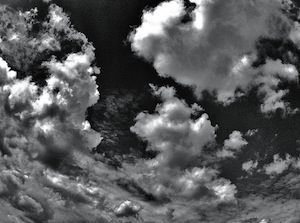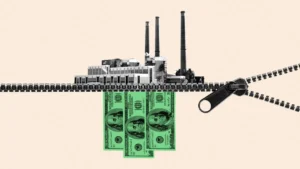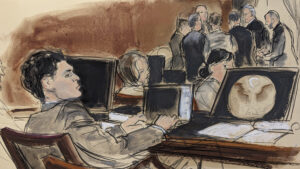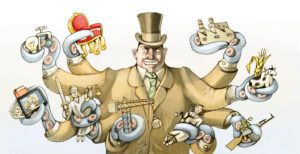Hurricane Sandy in the Age of Disposability and Neoliberal Terror
Hurricane Sandy not only failed to arouse a heightened sense of moral outrage and call for justice, it has quickly been woven into a narrative that denied those larger economic and political forces, mechanisms and technologies by which certain populations are rendered human waste.
By Henry A. Giroux, TruthoutThis piece originally appeared at Truthout.The winners in the disposable society circulate close to the top of the power pyramid…. Those who can’t afford to be on the move stand little chance…. Market freedom means few people have a hold on the present and that everyone is expendable.
–Zygmunt Bauman
In the aftermath of Hurricane Katrina, shocking images of dead bodies floating in the flood waters of New Orleans appeared on national TV against a sound track of desperate cries for help by thousands of poor, black, brown, elderly and sick people. These disturbing pictures revealed a vulnerable and destitute segment of the nation’s citizenry that conservatives not only refused to see as such, but had spent the better part of three decades demonizing. But the haunting images of the abandoned, desperate and vulnerable would not go away and for a moment imposed themselves on the collective conscience of Americans, demanding answers to questions that were never asked about the existence of those populations excluded from the American dream and abandoned to their own limited resources in the midst of a major natural disaster. But that moment soon passed as the United States faced another disaster: The country plunged into an economic turmoil ushered in by finance capital and the apostles of Wall Street in 2008.[1] Consequently, an additional instance of widespread hardship and suffering soon bore down on lower-middle and working-class people who would lose their jobs, homes, health care and their dignity.
Hurricane Sandy not only failed to arouse a heightened sense of moral outrage and call for justice, it has quickly, if not seamlessly, been woven into a narrative that denied those larger economic and political forces, mechanisms and technologies by which certain populations when exposed to a natural catastrophe are rendered human waste. One reason for this case of historical amnesia and ethical indifference may lie in the emerging vicissitudes of an era eager to accommodate rather than challenge global warming, an era in which freakish weather events have become such commonplace occurrences that they encourage the denial of planetary destruction. These days Americans are quickly fatigued by natural catastrophe. Major natural disasters and their consequences are now relegated to the airborne vocabulary of either fate or the unyielding circumstance of personal tragedy, conveniently allowing an ethically cleansed American public to ignore the sordid violence and suffering they produce for those populations caught in the grip of poverty, deprivation and hardship. It gets worse. Catastrophes have not only been normalized, they have been reduced to the spectacle of titillating TV. Rather than analyzed within broader social categories such as power, politics, poverty, race and class, the violence produced by natural disasters is now highly individualized, limited to human interest stories about loss and individual suffering. Questions concerning how the violence of Hurricane Sandy impacted differently those groups marginalized by race, age, sickness and class, particularly among poor minorities, were either downplayed or ignored.
Lost in both the immediacy of the recovery efforts and the public discourse in most of the mainstream media were the abandoned fates and needless suffering of residents in public-housing apartments from Red Hook to the Lower East Side, to the poorest sections of the Rockaway Peninsula and other neglected areas along the east coast of New Jersey. These are populations ravaged by poverty, unemployment and debt. Even though inequality has become one of the most significant factors making certain groups vulnerable to storms and other types of disasters, matters of power and inequality in income, wealth and geography rarely informed the mainstream media’s analysis of the massive destruction and suffering caused by Sandy. [2] And yet, out of 150 countries, the United States has the fourth highest wealth disparity.[3] As Joseph Stiglitz points out, “Nowadays, these numbers show that the American dream is a myth. There is less equality of opportunity in the United States today than there is in Europe – or, indeed, in any advanced industrial country for which there are data.”[4] Inequality and social disparity are not simply about the concentration of wealth and income into fewer hands, they are also about the unequal use of power, the shaping of policies and the privileging of a conservative wealthy minority who have accumulated vast amounts of wealth. America is paying a high price for its shameful levels of inequality and this became particularly clear when certain populations in Manhattan received aid more quickly than others in the post-Hurricane Sandy reconstruction efforts. Not surprising, given that Manhattan, one of the epicenters of the storm’s savagery, has a level of inequality that not only stands out but rivals parts of sub-Saharan Africa.[5] Within this geography of massive income and wealth inequality, 20 percent of Manhattan residents made $392,022 a year on average [and] the poorest made $9,681.
Yet, even though lower Manhattan was a low priority for receiving government and private relief efforts, neither its vulnerability nor the iniquitous treatment it was accorded was factored into post-Sandy media coverage.[6] Sandy lay bare what many people did not want to see: a throwaway society that not only endlessly created material waste, but one all too willing to produce and dispose of what it interprets as human waste. What is clear in this case is that while some attention was focused on the first responders who lost their homes in Breezy Point and the poor elderly trapped for days in housing projects, “facing cold temperatures, food shortages,” electrical failures and lack of proper medical care, these are populations whose lives are for the most part considered “unreal,” occupying a space of invisibility where hardships are rarely seen or heard.[7]
But more was revealed in this disaster than the painful registers of exclusion, mass suffering and the inability of government to provide timely help to those most vulnerable and in need of aid. Hurricane Sandy also revealed the gaping and dystopian fault lines of those disasters exacerbated by human actions in a society wracked by vast differences in power, income, wealth, resources and opportunities. In this instance a natural catastrophe merged with forms of sustained moral/social neglect and a discourse of symbolic violence to reveal a set of underlying determinants, a grammar of human suffering.The fundamental lesson of Hurricane Sandy is not to be found in the lack of disaster preparedness on the part of many cities, the race and class divisions at work in urban areas, the crisis of global warming or in the ways in which the rich and powerful used the destruction produced by superstorm Sandy to call for neoliberal reforms, though these demand our considered attention. Rather, it is in the coming dystopia, fashioned by natural disasters as much as political catastrophes, which reveals the spiraling violence of what can be called a neoliberal spectacle of humiliation and misery waged against those populations now viewed as expendable and disposable.[8]
Within this regime of neoliberal violence, the politics of disposability is shored up by the assumption that some lives and social relationships are not worthy of a meaningful social existence, empathy and social protections. Lacking social protections, such populations increasingly are addressed within the growing reach of the punishing state, as a source of entertainment, or are relegated to what Etienne Balibar calls the “death zones of humanity,” where they are rendered superfluous and subject to a mode of “production for elimination.”[9] In a culture defined by excessive inequality, suffering and cruelty, the protective covering of the state, along with the public values and the formative culture necessary for a democracy is corrupted.[10] And the disposable are not merely those populations caught in extreme poverty. Increasingly, they are individuals and groups now ravaged by bad mortgages, poor credit and huge debt. They are the growing army of the unemployed forced to abandon their houses, credit cards and ability to consume – a liability that pushes them to the margins of a market society. These are the groups whose homes will not be covered by insurance, who have no place to live, no resources to fall back on, no way to imagine that the problems they will be facing are not just personal, but deeply structural, built into a system that views the social contract and the welfare state as a lethal disease.
A callous indifference to the plight of the poor was made clear in the remarks of former presidential candidate Mitt Romney in his derogatory reference to the 47 percent of adult Americans who don’t pay income taxes for one reason or another as “people who believe that they are victims, who believe the government has a responsibility to care for them, who believe that they are entitled to health care, to food, to housing, to you-name-it.”[11] In a post-election comment, Romney reproduced this logic when telling a group of his financial backers that Obama won the election because he gave policy gifts to specific interest groups, “especially the African-American community, the Hispanic community and young people.”[12] In this instance, Romney simply affirmed Newt Gingrich’s more overtly racist claim that President Obama was a “food stamp president … who was comfortable sending a lot of people checks for doing nothing.”[13] Right-wing pundits such as Bill O’Reilly, Rush Limbaugh, Sarah Palin, and Sean Hannity, offered up additional examples of the discourse of disposability and culture of cruelty by claiming that 47 percent “want things” and are welfare moochers and “wards of the state.”[14] In this economic Darwinist measure of value, those marginalized by race and class, who might detract from, rather than enlarge another’s wealth are not only demonized, but are also viewed as problematic in that they become burdens to be disposed of, rather a valuable and treasured human resource in which to invest. But the discourse of disposability is not limited to right-wing politicians, pundits, conservative media apparatuses or a Republican Party that is now in the hands of extremists; it is also built into the vocabulary of liberal governmental policy.
This culture of cruelty and disposability was particularly visible as Mayor Michael Bloomberg initially was willing to divert scarce resources for storm relief such as food, power generators, police and fire personnel and public services to the New York Marathon rather than to the hardest hit victims of the killer hurricane, especially those residents in Staten Island. In the face of a public anger, Bloomberg eventually cancelled the event but not before he had made obvious the message that, as Chris Hedges points out, those who are poor and voiceless are expendable, “a drain on efficiency and progress. They are viewed as refuse. And as refuse … have no voice and no freedom …. This is a world where only corporate power and profit are sacred. It is a world of barbarism.”[15] The ideology of hardness and cruelty unleashed by neoliberal policy formulations was further highlighted as a number of right-wing policy advocates who argued in various mainstream news sources that the destruction wreaked by Sandy provided an excellent opportunity for privatizing the Natural Flood Insurance Program and eliminating labor protections and other regulations that hampered the superrich from using the disaster to rake in big profits. In one brazen, if not ruthless, suggestion written by right-wing economist Russell S. Sobel in a New York Times online forum, he argued that in the most devastated areas caused by Hurricane Sandy, “FEMA should create ‘free trade zones – in which all normal regulations, licensing and taxes [are] suspended.’ This corporate free-for-all would, apparently, ‘better provide the goods and services victims need.'”[16] This was somewhat at odds with an earlier suggestion by Mitt Romney that FEMA should actually be abolished in order to allow the private sector to take over disaster control.[17]
The lessons of Hurricane Sandy not only raise serious questions about the class and racial divides that characterize the United States and the seriousness of the ecological dangers that are reshaping weather patterns and destroying the globe, but also about forms of neoliberal power that escape any sense of moral responsibility and are answerable only to those who have power and seek profit at any cost. As neoliberalism spreads across the globe, there seems to be little that governments can do in fulfilling a broad central commitment to their citizens. This suggests that the American public become all the more attentive to what populations are dehumanized and considered excess, who is on the chopping block, who is being protected and who is being ignored. Zones of terminal exclusion, social death and what Hedges calls “sacrifice zones” are proliferating at a rapid pace in the United States.[18] These are the forgotten zones of interminable exclusion and social abandonment where Americans are trapped in never ending cycles of poverty, powerlessness, and hopelessness as a direct result of neoliberal policies that embrace capitalistic greed, while producing “areas that have been destroyed for quarterly profit. We’re talking about environmentally destroyed, communities destroyed, human beings destroyed, families destroyed.”[19]The growing legions of disposable populations cannot be separated from the ongoing attack by the apostles of neoliberalism on workers’ freedoms, women’s civil rights, public schools, the welfare state and other groups and institutions that get in the way of the extremely wealthy bankers, hedge fund managers and corporate CEOs who want to reshape America in the image of casino capitalism. America is awash in neoliberal culture of violence, which becomes all the more dangerous as the notion of moral conscience, like the notion of social agency, seems all but forgotten as moral obligations are reduced to the realm of self-obligations. Trapped in an unwillingness to translate private troubles into broader social considerations, the discourse of social protections is reduced to the vocabulary of charity and individual giving. In the aftermath of Hurricane Sandy, the overly washed elite have been discovering poverty while exoticizing the poor. Sarah Maslin Nir points critically to the elites’ immersion into poverty porn by noting their “voyeuristic interest in the plight of the poor, treating [their trip into disaster areas] as an exotic weekend outing.”[20] She also notes the complaint of a female resident of a Rockaway project who stood by “as volunteers snapped iPhone photos of her as she waited in line for donated food and clothing.”[21] The message was not lost on her as revealed by her comment that she and her friends felt as if they were “in a zoo.”[22]
Privatized discourses and a war-against-all ethos increase the likelihood of the disappearance of those considered disposable and are reinforced by a stripped-down notion of responsibility, which alleviates the weight of moral conscience and social obligations. It undermines and destroys, when possible, those modes of social agency, collective structures and bonds of sociality capable of holding power accountable, resisting the anti-democratic pressures of neoliberalism and imagining visions that prioritize an investment in the public good over visions of happiness characterized by an endless search for immediate gratification. In a society in which “markets are detached from morals” and a market economy is transformed into a market society, market values increasingly shape areas of everyday life where they do not belong.[23] As markets provide the only template by which to address all of society’s needs, money and expanding profit margins become the ultimate measure of one’s worth, and consuming the ultimate index of what it means to invest in one’s identity, relations with others and the larger society.
Social rights and nonmarket values no longer matter and consequently an increasing number of individuals and groups are removed from any kind of ethical grammar that would acknowledge those economic, political and social forces that produce their suffering and marginalization. Such groups are increasingly punished if they are homeless, poor, unemployed or in debt. Institutions once meant to abolish human suffering now produce it.[24] Three strikes sentencing laws have “created a cruel, Kafkaesque criminal justice system that lost all sense of proportion, doling out life sentences disproportionately to back defendants.”[25] We are living through what psychologist Robert Jay Lifton rightly calls a “death-saturated age” in which matters of violence, survival and trauma inescapably saturate everyday life.[26] Such anti-democratic forces are not new, but they have been intensified and deepened under expanding neoliberal policies. They have also been reconfigured in more powerful and lethal ways through a frontal assault on the social contract, the welfare state and social protections.[27] Positive visions of the good society and the importance of public values and civic life are being destroyed under the dominance of regressive and reactionary neoliberal institutions, ideologies, values and social relations. Market fundamentalism is the driving force of our times and it has destroyed the formative culture, rules of law, economic institutions, public spheres and governing structures necessary for a democracy to survive.
At first glance, America seems to be inured to the ongoing threat of ecological disasters, and indifferent to the plight of those disposable populations who suffer most from the increasing catastrophes – natural and human – that range from massive inequality and poverty, to droughts and floods that threaten the planet, but new visions are arising among young people across the United States and the globe who refuse to equate capitalism with democracy and accept a future shaped by the nightmarish imperatives of a neoliberal society.[28] America needs a new language for politics, justice, compassion and the obligations of citizenship. The individual citizen cannot be reduced to the individual consumer, a democratic society cannot collapse into the image of the market, and human beings cannot be dehumanized and reduced to human waste, excess and disposability. Teddy Cruz is right in arguing that, “Democracy is not simply the right to be left alone. Rather it is defined by the co-existence with others in space, a collective ethos, regardless of social media, that unconditionally stands for [economic, political, and] social rights.”[29] Democracy can only approach its promise when it protects all members of society. As Bauman argues, “Society can only be raised to the level of community as long as it effectively protects its members against the horrors of misery and indignity; that is, against the terrors of being excluded [and] being condemned to ‘social redundancy’ and otherwise consigned to [being] ‘human waste.'”[30]
In such dark times, the American public cannot trap itself in a crisis of negation, one that rules out the historical possibility of struggle, resistance and emancipatory change.[31] This suggests the need to challenge the corrupt and moribund version of democracy that now dominates the United States, but also to imagine what kind of institutions, culture, power relations and modes of governance would be possible in a radical democracy. At stake here is not just the need for developing an enlightened civic imagination that embraces the moral concepts of conscience, decency, self-respect and human dignity, but also a notion of collective struggle that fights for the social foundations that make these concepts and progressive public policy meaningful. In part, this can only happen when humankind frees itself from dehumanizing human beings, turning them into surplus commodities or making them entirely redundant.[32] Employing a language of both critique and hope merges the need for a new vocabulary of struggle and politics with a fresh approach to a future that refuses to mimic the present.The late Tony Judt argued that the American public needs to open a new conversation about politics, the language of justice, popular rights and the rhetoric of public action. Judt feared that the most dangerous threat America faced was the corrosive “loss of conviction, a loss of faith in the culture of open democracy, a sense of skepticism and withdrawal which is probably already quite far advanced.”[33] Judt argues that progressives need to move beyond single issue movements such as climate change in order to address and regroup such issues “into a conversation about society at large.”[34] He rightly argued that what has “been lacking for social movements [is the need] to find a common ground beyond the fragmentation of particularized politics, to address the totality of systems steeped in authoritarian practices.”[35] The politics of the wreckage produced by superstorm Sandy and disposability can only be understood within a broader view of society. Hurricane Sandy reminds Americans that they have to be vigilant about what populations are considered disposable, what lives are considered “unreal … neither alive nor dead, but interminably spectral.”[36] Sandy prompts the American public to be more than moved in a moment of crisis in order to become more responsible to what is happening within a larger constellation of political, historical, economic and cultural forces. If we ignore these warnings, not only will an increasing number of individuals and groups become disposable, but the very promise of democracy will be rendered unintelligible, cast outside of the realm of reason, hope, and struggle.
Notes:
1. A number of important books have appeared addressing this financial crisis, some recent examples include: Jeff Marrick, The Age of Greed: The triumph of Finacne and the Decline of America, 1970 to the Present (New York: Vintage, 2011); John Bellamy Foster and Robert W. McChesney, The Endless Crisis: How Monopoly-Finance capital Produces Stagnation and Upheaval from the USA to China (New York: Monthly Review Press, 2012); Charles H. Ferguson, Predator Nation: Corporate Criminals, Political Corruption, and the Hijacking of America (New York: Crown Publishing, 2012); Christopher Hayes, Twilight of Elites: America After Meritocracy (New York: Crown Publishing, 2012); Richard Wolf, Occupy the Economy: Challenging Capitalism (San Francisco: City Lights, 2012).
2. Some of the more recent sources on the politics of inequality that are worth reading include: Joseph Stiglitz, The Politics of Inequality (New York: Norton, 2012) and Richard Wilkinson and Kate Pickett, The Spirit Level: Why Equality is better for Everyone (New York: Penguin Press, 2010).
3. Paul Buchheit, “Five Misconceptions about our Tattered Safety Net,” Common Dreams, (November 12, 2012).
4. Joseph E. Stiglitz, “The Price of Inequality,” Project Syndicate, (June 5, 2012)
5. Sarah Seltzer, “Hurricane Sandy: Income inequality writ large,” Salon, (November 1, 2012).
6. Ibid., David Rohde, “The Hideous Inequality Exposed by Hurricane Sandy.” The Atlantic, (October 31, 2012).
7. John Leslie, “After Sandy: Political Storm Coming?” Socialist Organizer, (November 5, 2012).
8. On the politics of disposability, see [1] João Biehl, Vita: Life in A Zone of Social Abandonment, (Los Angeles, CA: University of California Press, 2005); Zygmunt Bauman, Wasted Lives, (London: Polity Press, 2004); Henry A. Giroux, Stormy Weather: Katrina and the Politics of Disposability (Boulder, Paradigm, 2006); Judith Butler, Precarious Life: The Powers of Mourning and Violence, (London: Verso Press, 2004); Achille Mbembe, “Necropolitics”, translated by Libby Meintjes, Public Culture, 15:1 (2003), pp. 11-40.
9. Etienne Balibar, “Outline of a Topography of Cruelty: Citizenship and Civility in the Era of Global Violence,” We, the People of Europe? Reflections on Transnational Citizenship, (Princeton: Princeton University Press, 2004), p. 128.
10. See, for example, Larry M. Bartels, Unequal Democracy: The Political Economy of the New Gilded age (Princeton: Princeton University Press, 2008); John K. Galbraith, The Predator State (New York: Free Press, 2008); Jacob S. Hacker & Paul Pierson, Winner-Take-All Politics: How Washington Made the Richer Richer—And Turned Its Back on the Middle Class (New York: Simon and Schuster, 2010) and Juliet B. Schor, Plenitude: The New Economics of True Wealth (New York: The Penguin Press, 2010).
11. Corn, “Secret Video.
12. Ashley Parker, “Romney Blames Loss on Obama’s ‘Gifts’ to Minorities and Young Voters,” New York Times (November 14, 2012), p. A23.
13. Nsenga K. Burton, “Obama has not undermined welfare reform,” Star Telegram (September 19, 2012).
14. Cited in Amy Goodman, “Tavis Smiley, Cornel West on the 2012 Election & Why Calling Obama “Progressive” Ignores His Record,” Democracy Now, (November 9, 2012)
15. Chris Hedges, “Elites Will Make Gazans of Us All,” Truthdig, (November 19, 2012)
16. Cited in Naomi Klein, “Superstorm Sandy – a People’s Shock?” The Nation, (November 5, 2012).
17. Editorial “A Big Storm Requires Big Government,” The New York Times, (October 29, 2012).; Joan Walsh, “Mitt Blows it on Sandy: Did the Hurricane Just Cost Him the Election?” Alternet, (October 31, 2012).
18. Chris Hedges and Joe Sacco, Days of Destruction Days of Revolt (Toronto: Knopf Canada, 2012).
19. Bill Moyer Interviews Chris Hedges, “Capitalism’s ‘Sacrifice Zones,’” Moyer’s & Company (July 20, 2012).
20. Sarah Maslin Nir, “Helping Hands Also Expose a New York Divide,” The New York Times, (November 16, 2012), p. A1
21. Ibid.
22. Ibid.
23. Michael J. Sandel, What Money Can`t Buy: The Moral Limits of Markets (New York: Farrar, Straus and Giroux, 2012), p. 6.
24. See, for instance, Joe Soss, Richard C. fording, and Sanford F. Schram, Disciplining the Poor: Neoliberal Paternalism and the Persistent Power of Race (Chicago: University of Chicago Press, 2011); Michelle Alexander, The New Jim Crow: Mass Incarceration in the Age of Colorblindness (New York: The New Press, 2010); Loic Wacquant , Punishing the Poor: The Neoliberal Government of Social Insecurity, (Durham, NC: Duke University Press, 2009) and Angela Y. Davis, Abolition Democracy: Beyond Empire, Prisons, and Torture, (Seven Stories Press, 2005).
25. Brent Staples, “California Horror Stories and the 3-Strikes Law,” New York Times (November 25, 2012), p. SR10.
26. Robert Jay Lifton, Death in Life: Survivors of Hiroshima (Chapel Hill: U of North Carolina Press, 199, p. 479; See Lynn Worsham’s brilliant use of Lifton’s work in her “Thinking With Cats (More to Follow), JAC 30, 3-4 (2010), pp. 405-433.
27. See Tony Judt, Ill Fares the Land, (New York, N.Y.: the Penguin Press, 2010).
28. See for example, Henry A. Giroux, Youth in Revolt: Reclaiming a Democratic Future (Boulder: Paradigm Publishers, 2013); Richard Wolff, Occupy the Economy (San Francisco, City Lights Books, 2012); Noam Chomsky, Occupy (New York: Succotti Park Press, 2012); Manuel Castells, Networks of Outrage and Hope: Social Movements in the Internet Age (Cambridge, Polity Press, 2012).
29. Teddy Cruz, “Democratizing Urbanization and the Search for a New Civic Imagination,” in Nato Thompson, ed. Living as Form: Socially Engaged Art from 1991-2011 (Cambridge: The MIT Press, 2012), p. 57.
30. Zygmunt Bauman, Living on Borrowed Time: Conversations with Citlali Rovirosa-Madrazo, (Cambridge, UK: Polity Press, 2010), pp. 6-7.
31. John Van Houdt, “The Crisis of Negation: An Interview with Alain Badiou,” Continent, 1.4 (2011): 234-238.
32. On this issue, see, in particular, Leo Lowenthal, “Atomization of Man,” False Prophets: Studies in Authoritarianism, (New Brunswick, NJ: Transaction Books, 1987), pp. 181-91, and Judith Butler, Precarious Life: The Powers of Mourning and Violence (London: Verso Press, 2004).
33. Tony Judt, “I am not pessimistic in the very long run,” The Independent, (March 24, 2010
34. Ibid., Tony Judt, “I am not pessimistic in the very long run.”
35. Ibid., Tony Judt, “I am not pessimistic in the very long run.”
36. Ibid., Judith Butler, Precarious Life, pp. 33-34.
Your support matters…Independent journalism is under threat and overshadowed by heavily funded mainstream media.
You can help level the playing field. Become a member.
Your tax-deductible contribution keeps us digging beneath the headlines to give you thought-provoking, investigative reporting and analysis that unearths what's really happening- without compromise.
Give today to support our courageous, independent journalists.






You need to be a supporter to comment.
There are currently no responses to this article.
Be the first to respond.